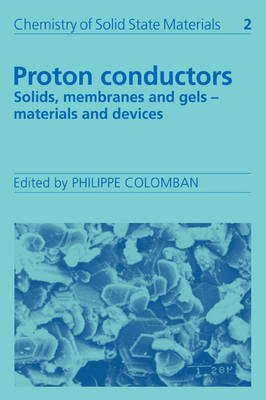
Proton Conductors
Cambridge University Press (Verlag)
978-0-521-07890-0 (ISBN)
Protonic conduction in liquid electrolytes is commonplace but is relatively rare in solids. There is much interest worldwide in proton conducting solids, both from the scientific aspect, as materials with novel properties, but also for their possible applications in high-density solid-state batteries, sensors and other electrochemical devices. This book gives a comprehensive review of proton conductors, including theory, techniques, the materials themselves and applications.
List of contributors; Preface; Part I. The Hydrogen Bond and Protonic Species: 1. The hydrogen bond and chemical parameters favouring proton mobility in solids A. Potier; 2. Protonic species and their structures D. J. Jones and J. Rozière; 3. Proton conductors: classification and conductivity Ph. Colomban and A. Novak; 4. Defects, non-stoichiometry and phase transitions Ph. Colomban and A. Novak; 5. Structural studies of proton conductors J. O. Thomas; 6. Hydrogen in metals: structure, diffusion and tunnelling I. Svare; Part II. Materials: Preparation, Structures and Properties: 7. Structure and characterization of hydrogen insertion compounds of metal oxides P. G. Dickens and A. M. Chippindale; 8. High temperature proton conductors based on perovskite-type oxides H. Iwahara; 9. Highly ionic hydroxides: unexpected proton conductivity in Mg(OH)2 and homologues F. Freund; 10. Ice I. A. Ryzhkin; 11. Anhydrous materials: oxonium perchlorate, acid phosphates, arsenates, sulphates and selenates Ph. Colomban and A. Novak; 12. Hydrogen behaviour in graphite-nitric acid intercalation compounds H. Fuzellier and J. Conard; Section 1. A. Inorganic Ion Exchangers: 13. Proton-containing ß- and ß"-alumina structure type compounds H. Ikawa; 14. Proton conduction in zeolites E. Krogh Andersen, I. G. Krogh Anderson and E. Skou; 15. Proton containing NASICON phases A. Clearfield; Section 2. B. Layer Hydrates: 16. Phosphates and phosphonates of tetravalent metals as protonic conductors G. Alberti and M. Casciola; 17. Hydrogen uranyl phosphate H3OUO2PO4.3H2O (HUP), and related materials Ph. Colomban and A. Novak; 18. From crystalline to amorphous (particle) hydrates: inorganic polymers, glasses, clays, gels and porous media Ph. Colomban and A. Novak; 19. Perfluorinated membranes G. Pourcelly and C. Gavach; 20. Mixed inorganic–organic systems: the acid/polymer blends J. C. Lassègues; Part III. Proton Dynamics and Charge Transport: 21. Incoherent neutron scattering studies of proton conductors: from the anhydrous solid state to aqueous solutions J. C. Lassègues; 22. NMR studies of local motions in fast protonic conductors S. V. Bhat; 23. Vibrational spectroscopy of proton conductors Ph. Colomban and A. Novak; 24. Raman spectroscopic studies of proton conductors R. Frech; 25. Frequency dependent conductivity, microwave dielectric relaxation and proton dynamics Ph. Colomban and J. C. Badot; 26. Measuring the true proton conductivity K.-D. Kreuer; 27. D.c. techniques and a.c./d.c. combination techniques E. Skou, I. G. Krogh Andersen and E. Krogh Andersen; 28. NMR in gels and porous media J. P. Korb and F. Devreux; Part IV. Proton Diffusion Mechanisms: 29. Mobility in hydrogen-containing oxide bronzes: the atomic-level detail R. C. T. Slade; 30. Conductivity mechanisms and models in anhydrous protonic conductors Ph. Colomban and A. Novak; 31. Conduction mechanisms in materials with volatile molecules K.-D. Kreuer; Part V. Devices: Section 1. A. Energy Storage and Production: 32. Applications of perfluorinated proton conductors (Nafions) C. Gavach and G. Pourcelly; 33. Synthesis of polycrystalline H30+ and NH4+ß/ß"Al203 and potential application in steam electrolysis/fuel-cells P. S. Nicholson; 34. Fuel-cells, steam-electrolysis for hydrogen production and hydrogen separation using high temperature protonic conductors H. Iwahara; Section 2. B. Small Components and Microionic Devices: 35. Ice-based devices I. A. Ryzhkin; 36. Solid-state gas sensors operating at room temperature N. Miura and N. Ymazoe; 37. All solid-state protonic batteries J. Guitton, C. Poinsignon and J. Y. Sanchez; 38. Applications of proton conductors in electrochromic devices (ECDs) O. Bohnke; 39. Supercapacitors and interfacial charge accumulation devices Ph. Colomban and M. Pham-Thi; Index.
| Erscheint lt. Verlag | 11.9.2008 |
|---|---|
| Reihe/Serie | Chemistry of Solid State Materials |
| Zusatzinfo | 16 Tables, unspecified; 3 Halftones, unspecified; 124 Line drawings, unspecified |
| Verlagsort | Cambridge |
| Sprache | englisch |
| Maße | 153 x 230 mm |
| Gewicht | 916 g |
| Themenwelt | Naturwissenschaften ► Chemie ► Anorganische Chemie |
| ISBN-10 | 0-521-07890-3 / 0521078903 |
| ISBN-13 | 978-0-521-07890-0 / 9780521078900 |
| Zustand | Neuware |
| Haben Sie eine Frage zum Produkt? |
aus dem Bereich


